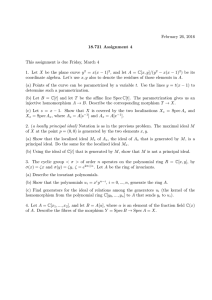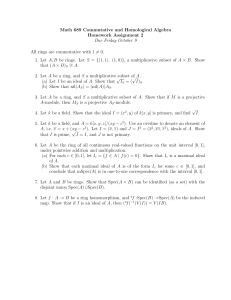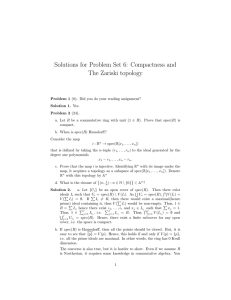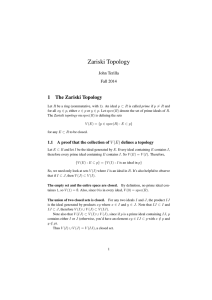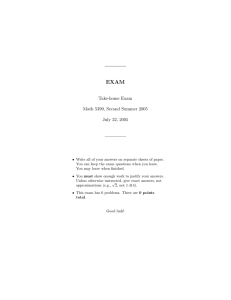SPECTRAL TOPOLOGIES OF DUALLY RESIDUATED LATTICE-ORDERED MONOIDS (
advertisement
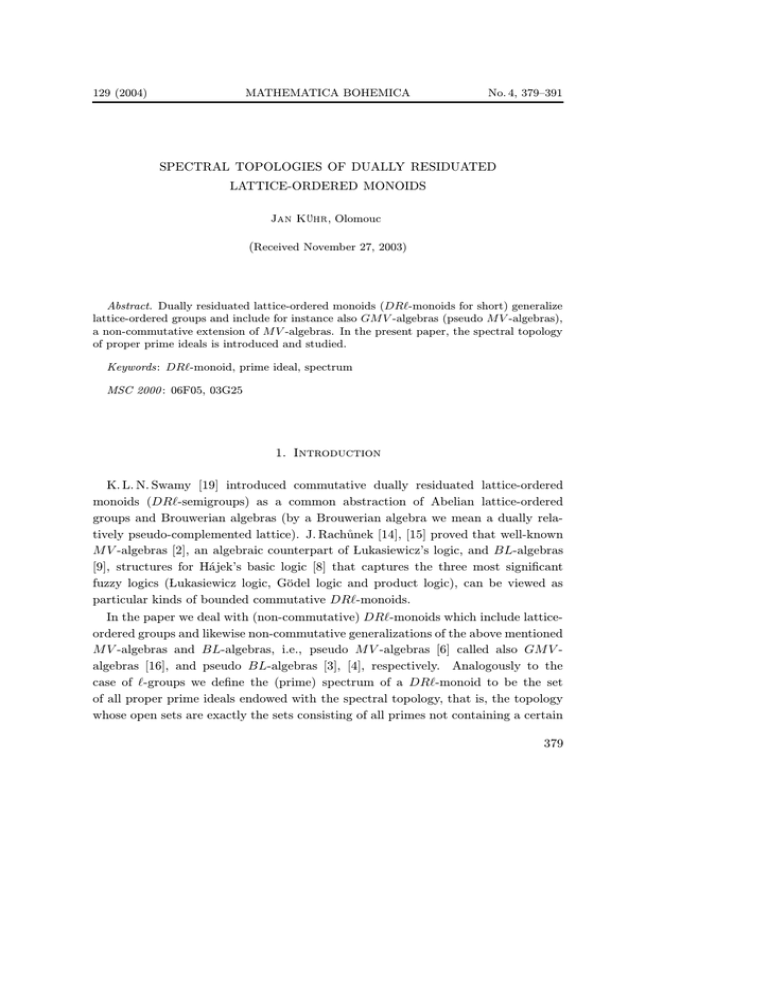
129 (2004)
MATHEMATICA BOHEMICA
No. 4, 379–391
SPECTRAL TOPOLOGIES OF DUALLY RESIDUATED
LATTICE-ORDERED MONOIDS
, Olomouc
(Received November 27, 2003)
Abstract. Dually residuated lattice-ordered monoids (DR`-monoids for short) generalize
lattice-ordered groups and include for instance also GM V -algebras (pseudo M V -algebras),
a non-commutative extension of M V -algebras. In the present paper, the spectral topology
of proper prime ideals is introduced and studied.
Keywords: DR`-monoid, prime ideal, spectrum
MSC 2000 : 06F05, 03G25
1. Introduction
K. L. N. Swamy [19] introduced commutative dually residuated lattice-ordered
monoids (DR`-semigroups) as a common abstraction of Abelian lattice-ordered
groups and Brouwerian algebras (by a Brouwerian algebra we mean a dually relatively pseudo-complemented lattice). J. Rachůnek [14], [15] proved that well-known
M V -algebras [2], an algebraic counterpart of Lukasiewicz’s logic, and BL-algebras
[9], structures for Hájek’s basic logic [8] that captures the three most significant
fuzzy logics (Lukasiewicz logic, Gödel logic and product logic), can be viewed as
particular kinds of bounded commutative DR`-monoids.
In the paper we deal with (non-commutative) DR`-monoids which include latticeordered groups and likewise non-commutative generalizations of the above mentioned
M V -algebras and BL-algebras, i.e., pseudo M V -algebras [6] called also GM V algebras [16], and pseudo BL-algebras [3], [4], respectively. Analogously to the
case of `-groups we define the (prime) spectrum of a DR`-monoid to be the set
of all proper prime ideals endowed with the spectral topology, that is, the topology
whose open sets are exactly the sets consisting of all primes not containing a certain
379
ideal. Prime spectra of commutative representable DR`-monoids were studied by
J. Rachůnek [13] who also examined spectra of GM V -algebras [17].
The present definition of a (non-commutative) dually residuated lattice-ordered
monoid is due to T. Kovář [10]:
An algebra (A; +, 0, ∨, ∧, *, )) of signature h2, 0, 2, 2, 2, 2i is called a dually residuated lattice-ordered monoid (DR`-monoid) if
(1) (A; +, 0, ∨, ∧) is a lattice-ordered monoid (`-monoid), i.e., (A; +, 0) is a monoid,
(A; ∨, ∧) is a lattice and the semigroup operation distributes over the lattice
operations,
(2) for any a, b ∈ A, a * b is the least x ∈ A such that x + b > a, and a ) b is the
least y ∈ A such that b + y > a,
(3) A fulfils the identities
((x * y) ∨ 0) + y 6 x ∨ y,
x * x > 0,
y + ((x ) y) ∨ 0) 6 x ∨ y,
x ) x > 0.
As observed in [10], the identities in (3) hold even with “6” replaced by “=” and
it can be easily shown that the condition (2) is equivalent to the system of identities
(x * y) + y > x,
y + (x ) y) > x,
x * y 6 (x ∨ z) * y,
(x + y) * y 6 x,
x ) y 6 (x ∨ z) ) y,
(y + x) ) y 6 x.
Let us recall some necessary facts concerning ideals of DR`-monoids [11], [12]. Let
A be a DR`-monoid. Since A has no least element in general, we define the absolute
value of x ∈ A by |x| = x ∨ (0 * x) (or equivalently, |x| = x ∨ (0 ) x)). Of course,
x > 0 iff x = |x|.
A non-empty subset I of A is said to be an ideal in A if (i) x + y ∈ I for all
x, y ∈ I, and (ii) |y| 6 |x| entails y ∈ I for all x ∈ I and y ∈ A. Under the ordering
by set-inclusion, the ideals of any DR`-monoid form an algebraic, distributive (and
hence relatively pseudo-complemented) lattice, the ideal lattice Id(A). For every
X ⊆ A, the set
I(X) = {a ∈ A : |a| 6 |x1 | + . . . + |xn | for some x1 , . . . , xn ∈ X, n ∈ }
is the least ideal in A containing X, thus in particular for each x ∈ A we have
I(x) = {a ∈ A : |a| 6 n|x| for some n ∈ }.
380
In addition, I(x) ∩ I(y) = I(|x| ∧ |y|) and I(x) ∨ I(y) = I(|x| ∨ |y|) = I(|x| + |y|),
which obviously yields that every finitely generated ideal is principal, and therefore
the compact elements of Id(A) are just the principal ideals.
An ideal I is called normal if a + I + = I + + a for all a ∈ A, where I + = {x ∈
I : x > 0}. The normal ideals of A correspond one-to-one to its congruence relations.
Under this correspondence, I corresponds to θI = {hx, yi : (x * y) ∨ (y * x) ∈ I}.
We shall write A/I for A/θI and x/I as an abbreviation of [x]θI . It is worth adding
that in A/I we have x/I 6 y/I iff (x * y) ∨ 0 ∈ I.
We define an ideal I to be prime if for all J, K ∈ Id(A), if J ∩ K ⊆ I then J ⊆ I
or K ⊆ I. In view of the distributivity of Id(A), I is prime if and only if it is meetirreducible in Id(A), i.e., J ∩ K = I implies J = I or K = I for all J, K ∈ Id(A). If,
moreover, A fulfils the identities
(∗)
(x * y) ∧ (y * x) 6 0,
(x ) y) ∧ (y ) x) 6 0,
then any ideal I is prime if and only if the set of all ideals exceeding I is totally
ordered, and a normal ideal I is prime if and only if A/I is totally ordered. When
regarded as DR`-monoids, all `-groups, GM V -algebras and pseudo BL-algebras satisfy (∗).
Every ideal is the intersection of all primes including it since by [12], Theorem 2.2,
for each proper ideal I and a ∈
/ I, there exists a prime ideal P with I ⊆ P and a ∈
/ P.
However, we shall need somewhat more:
Lemma 1. Let A be a DR`-monoid and `(A) the lattice reduct of A. If I ∈ Id(A)
and D is a filter in `(A) such that I ∩ D = ∅, then I ⊆ P and P ∩ D = ∅ for some
proper prime ideal P .
.
By Zorn’s lemma there exists a maximal ideal, say P , such that I ⊆ P
and P ∩D = ∅. It remains to show that P is prime. To do this assume that P = J ∩K
for some J, K ∈ Id(A) \ {P }. Then I is contained in both J and K and there are
x ∈ J ∩ D and y ∈ K ∩ D. Therefore |x| ∧ |y| ∈ J ∩ K ∩ D = P ∩ D = ∅, which is
impossible.
. Let A be a DR`-monoid, X ⊆ A and a ∈ A. We use X + to denote
the set comprising those x ∈ X for which x > 0, and we write a+ for a ∨ 0. In any
lattice L, [X) denotes the filter generated by X ⊆ L. If L is algebraic, then Com(L)
stands for the join-subsemilattice of all compact elements in L.
381
2. The spectrum
Let A be a DR`-monoid. The spectrum of A, denoted by Spec(A), is the set of
all proper prime ideals in A. For any X ⊆ A, let
S(X) = {P ∈ Spec(A) : X
P}
and
H(X) = {P ∈ Spec(A) : X ⊆ P }.
We write simply S(x) and H(x) instead of S({x}) and H({x}), respectively.
Lemma 2. For each X ⊆ A, S(X) = S(I(X)) and H(X) = H(I(X)).
.
It is easily seen that if X P for P ∈ Spec(A), then I(X) P ; thus
S(X) ⊆ S(I(X)). Conversely, X ⊆ P yields I(X) ⊆ P for any P ∈ Spec(A), and so
S(I(X)) ⊆ S(X). One analogously verifies H(X) = H(I(X)).
Consequently, it will be enough to study S(X) and H(X) for X ∈ Id(A). In
particular, we will observe S(x) = S(I(x)) and H(x) = H(I(x)) for x ∈ A+ , since
I(x) = I(|x|) for each x.
Let us recall the concept of a polar. We say that x, y ∈ A are orthogonal and
write x ⊥ y if |x| ∧ |y| = 0. The polar of an ideal X is the set
X ⊥ = {a ∈ A : a ⊥ x for all x ∈ X}.
The polar X ⊥ is the pseudo-complement of an ideal X in the lattice Id(A). Moreover,
by [12], Corollary 2.3 and Corollary 3.4, we have
Lemma 3.
X=
for any X ∈ Id(A).
\
H(X) and X ⊥ =
\
S(X)
Lemma 4. The following properties hold in any DR`-monoid A:
(1) S(0) = ∅ and S(A) = Spec(A);
(2) S(x ∧ y) = S(x) ∩ S(y) for all x, y ∈ A+ ;
(3) S(x ∨ y) = S(x) ∪ S(y) for all x, y ∈ A+ ;
(4) S(X ∩ Y ) = S(X) ∩ S(Y ) for all X, Y ∈ Id(A);
(5) for any collection {Xi }i∈I of ideals in A,
_ [
S(Xi ).
S
Xi =
i∈I
382
i∈I
.
The property (1) is obvious as 0 belongs to any ideal and neither of the
proper prime ideals includes A.
We have only to prove (4) and (5) as by [11], Proposition 12, I(x ∧ y) = I(x) ∩ I(y)
and I(x ∨ y) = I(x) ∨ I(y) for all x, y ∈ A+ . But both (4) and (5) are almost evident:
It is clear that for any P ∈ Spec(A), X ∩ Y
P entails X
P and Y
P.
Conversely, if X ∩ Y ⊆ P then X ⊆ P or Y ⊆ P since P is prime. Thus S(X ∩ Y ) =
S(X) ∩ S(Y ). Similarly (5).
Corollary 5. Given any DR`-monoid A, S = {S(X) : X ∈ Id(A)} is a topology
on Spec(A).
Thus Spec(A) endowed with S is a topological space that will be called the (prime)
spectrum of A; S is said to be the spectral topology of A.
Proposition 6. (1) If P ∈ Spec(A) then
B(P ) = {S(x) : x ∈ A+ \ P }
is a basis for Spec(A) at P .
(2) The set
B = {S(x) : x ∈ A+ }
is a basis for the topology Spec(A).
. To see (1), suppose P ∈ Spec(A) and P ∈ S(X) for some S(X) ∈ S,
i.e. X P . Then there is x ∈ X + \ P and hence P ∈ S(x) ⊆ S(X) as desired. The
statement (2) has a similar proof.
Proposition 7. Let A be a DR`-monoid. Then the mapping X 7→ S(X) is an
isomorphism between the ideal lattice Id(A) and the lattice of open sets of Spec(A).
.
Obviously X 7→ S(X) is onto and by Lemma 4 it is a homomorphism.
T
In addition, X = H(X) for each X ∈ Id(A) and therefore, if S(X) = S(Y ) then
X = Y as H(X) = H(Y ) iff S(X) = S(Y ).
A positive element u ∈ A+ is called a strong order unit if for any x ∈ A there exists
a positive integer k such that x 6 ku. It is easy to see that u ∈ A is a strong order
unit if and only if I(u) = A, so DR`-monoids with a strong order unit generalize
bounded DR`-monoids.
Since the ideal lattice Id(A) is an algebraic lattice whose compact elements are
exactly principal ideals, we immediately obtain
383
Corollary 8. For any x ∈ A, S(x) is a compact subset in Spec(A). The topological space Spec(A) is compact if and only if A possesses a strong order unit.
Proposition 9. Given a DR`-monoid A, Spec(A) is a T0 -space.
.
If P, Q ∈ Spec(A) are distinct, then P
Then Q ∈ S(P ) yet P ∈
/ S(P ).
Q or Q
P , say P
Q.
Let us denote by Specm (A) the set of all minimal prime ideals in a DR`-monoid
A and by Max(A) the set of all its maximal ideals provided it is non-empty. (In
general, A may have no maximal ideal.) As pointed out before, every ideal equals the
intersection of all prime ideals exceeding it, and hence every maximal ideal is prime
[12], i.e. Max(A) ⊆ Spec(A). In what follows, we shall investigate some properties of
the subspaces Specm (A) and Max(A).
Proposition 10. For any DR`-monoid A, both Specm (A) and Max(A) are T1 spaces.
.
If P, Q belong to Specm (A) or Max(A), then P and Q are incomparable
and hence P ∈ S(Q) and Q ∈ S(P ).
Proposition 11. Let A be a DR`-monoid satisfying the identities (∗). If P and Q
are incomparable proper prime ideals of A, then there exist disjoint neighbourhoods
of P and Q in Spec(A).
.
Since P
Q and Q P , one can find x ∈ P + \ Q and y ∈ Q+ \ P ,
thus P ∈ S(y) and Q ∈ S(x). By replacing x by (x * y)+ and y by (y * x)+ we
may assume that x ⊥ y, which yields S(x) ∩ S(y) = ∅ by Lemma 4.
Corollary 12. If A satisfies (∗) then both Specm (A) and Max(A) are T2 -spaces.
Let a ∈ A \ {0}. By Zorn’s lemma there exists an ideal M , called a value of a in
A, which is maximal not containing a. The set of all values of a in A is denoted by
ValA (a). Observe that every M ∈ ValA (a) is a prime ideal. Indeed, if M = J ∩ K for
some J, K ∈ Id(A) \ {M }, then certainly a ∈ J and a ∈ K, whence a ∈ J ∩ K = M ,
a contradiction. Therefore, ValA (a) ⊆ S(a) for all a ∈ A \ {0}. In addition, if A
satisfies (∗) then for each P ∈ S(a), the set of all ideals exceeding P is totally ordered
by set-inclusion [12], so there is a unique M ∈ ValA (a) such that P ⊆ M .
384
Proposition 13. If A satisfies (∗) then the mapping ϕ : S(a) → ValA (a) which
to each P ∈ S(a) assigns M , the unique value of a containing P , is continuous.
.
Let a ∈ A \ {0} and P ∈ S(a). Let U be a neighbourhood of ϕ(P )
in ValA (a), a subspace of Spec(A). Since {ValA (a) ∩ S(x) : x ∈ A+ } is a basis for
ValA (a), we may assume that U = ValA (a) ∩ S(x) for some x ∈ A+ .
Observe that if Q ∈ ValA (a) \ S(x), then Q and ϕ(P ) are incomparable, and hence
by Proposition 11 there exists a neighbourhood UQ of Q and a neigbourhood VQ of
ϕ(P ) (and hence of P ) in S(a) such that UQ ∩ VQ = ∅. The set of all such UQ forms
a covering of S(a) \ S(x). Indeed, if R ∈ S(a) \ S(x) then ϕ(R) ∈ ValA (a) \ S(x) and
R ∈ Uϕ(R) since Uϕ(R) = S(a) ∩ S(I) for some I ∈ Id(A), so I ϕ(R) entails I R.
Furthermore, S(a) is a compact subspace of Spec(A), S(a) \ S(x) = S(a) ∩ H(x)
is a closed subset in S(a), and therefore S(a) \ S(x) is compact in S(a). Hence there
are Q1 , . . . , Qn ∈ ValA (a) \ S(x) such that S(a) \ S(x) ⊆ UQ1 ∪ . . . ∪ UQn . This
yields S(a) ∩ S(x) = S(a) \ (S(a) \ S(x)) ⊇ S(a) \ (UQ1 ∪ . . . ∪ UQn ) = S(a) \ UQ1 ∩
. . . ∩ S(a) \ UQn ⊇ VQ1 ∩ . . . ∩ VQn (since UQi ∩ VQi = ∅ implies VQi ⊆ S(a) \ UQi ).
Let C = S(a) \ (UQ1 ∪ . . . ∪ UQn ) and V = VQ1 ∩ . . . ∩ VQn . Then V ∩ ValA (a) ⊆
C ∩ ValA (a) ⊆ S(a) ∩ S(x) ∩ ValA (a) = U. Since C is closed in S(a), it follows that
ϕ(C) ⊆ C ∩ ValA (a) ⊆ U. Indeed, C is closed iff C = S(a) ∩ H(I) for some I ∈ Id(A);
thus if R ∈ C then I ⊆ R whence I ⊆ ϕ(R), so ϕ(R) ∈ C ∩ ValA (a). Therefore we
obtain that ϕ(V) ⊆ U, where V is a neighbourhood of P in S(a).
Corollary 14. If A satisfies (∗) then ValA (a) is a compact T2 -space for all a ∈
A \ {0}.
.
This follows by a well-known fact that a continuous image of a compact
space is still compact: by the previous proposition, ValA (a) is a continuous image of
a compact space S(a).
It is obvious that if u is a strong order unit in A, then Max(A) = ValA (u) 6= ∅.
Corollary 15. If A satisfies (∗) and possesses a strong order unit u, then Max(A)
is a compact T2 -space.
We are now going to deal with the closure X of X ⊆ Spec(A), which will allow to
find the condition for Id(A) to be a Stone lattice.
Propositin 16. For any X ⊆ Spec(A), X = H(
.
T
X ).
First, observe that closed sets in Spec(A) are just H(I) for I ∈ Id(A).
T
It is easily seen that X ⊆ H( X ). Let now X ⊆ H(I) for some I ∈ Id(A). Then
T
T
T
I ⊆ P for all P ∈ X , so I ⊆ X which yields H( X ) ⊆ H(I). Hence H( X ) is
the smallest closed set including X .
385
T
Corollary 17. Let X ⊆ Spec(A). Then X is dense if and only if X = {0}, and
T
nowhere dense if and only if ( X )⊥ = {0}.
T
T
. Clearly, X is dense iff X = Spec(A) iff H( X ) = Spec(A) iff X =
T
{0}. Further, X is nowhere dense iff Spec(A) \ X is dense, i.e. Spec(A) \ X = {0}.
T
T
But X = H( X ), so that P ∈
/ X iff P ∈ S( X ) and this implies Spec(A) \ X =
T
T
T T
T ⊥
S( X ), so Spec(A) \ X = S( X ) = ( X ) .
T
Let us observe the case X = S(I) for some ideal I in A. We have S(I) = I ⊥ by
virtue of Lemma 3, and therefore we obtain the following:
Corollary 18. Let X be an ideal of a DR`-monoid A. Then S(X) is dense if and
only if X ⊥ = {0}; S(X) is nowhere dense if and only if X ⊥⊥ = {0}.
Corollary 19. For any X ∈ Id(A), S(X) is a clopen set if and only if S(X) =
H(X ⊥ ).
.
We have S(X) = H(X ⊥ ).
Proposition 20. Let X ∈ Id(A). Then S(X) is a clopen set in Spec(A) if and
only if X ∨ X ⊥ = A.
.
Let S(X) be clopen, i.e. S(X) = S(X) = H(X ⊥ ). Assume that
X ∨ X ⊥ 6= A. Then there is a ∈ A \ (X ∨ X ⊥ ), and thus by [12], Theorem 2.2,
one can find P ∈ Spec(A) such that X ∨ X ⊥ ⊆ P and a ∈
/ P . Hence X ⊆ P and
X ⊥ ⊆ P , so P ∈
/ S(X) yet P ∈ H(X ⊥ ), a contradiction.
Suppose that X ∨ X ⊥ = A and let P ∈ Spec(A). Since X ∩ X ⊥ = {0} and P is
prime, it follows that X ⊆ P or X ⊥ ⊆ P . Thus X P yields X ⊥ ⊆ P . Conversely,
if X ⊥ ⊆ P then X
P because otherwise A = X ∨ X ⊥ ⊆ P which is impossible.
Summarizing, X P iff X ⊥ ⊆ P for all P ∈ Spec(A), so S(X) = H(X ⊥ ).
Let Pol(A) be the set of all polars in A; again, it is partially ordered by setinclusion. Since the polars are precisely the pseudo-complements in the ideal lattice
Id(A), Pol(A) is a complete Boolean algebra which is a complete meet-subsemilattice
of Id(A) [12]. Obviously, Id(A) is a Stone lattice, i.e., Pol(A) is a sublattice of Id(A)
if and only if X ⊥ ∨ X ⊥⊥ = A for every ideal X. Hence by Proposition 20 we obtain
Theorem 21. The ideal lattice Id(A) of any DR`-monoid A is a Stone lattice if
and only if S(X ⊥ ) is clopen for all X ∈ Id(A).
Since any ideal X of a DR`-monoid A is a DR`-monoid again (as a matter of fact,
X is a convex subalgebra of A [11]), we can focus the prime spectrum of X. Our next
objective is to describe Spec(A/X), the spectrum of the quotient DR`-monoid over
386
a normal ideal X. The following results generalize [17], Theorem 5 and Theorem 12,
characterizing the spectra of quotient GM V -algebras and the spectra of principal
ideals generated by idempotent elements.
Lemma 22 [12]. If X ∈ Id(A) then the mappings
ϕ : P 7→ P ∩ X
and ψ : Q 7→ X ∗ Q,
where X ∗Q = {a ∈ A : |a|∧|x| ∈ Q for all x ∈ X} is the relative pseudo-complement
of X with respect to Q in Id(A), are mutually inverse order-isomorphisms between
the set S(X) consisting of all prime ideals in A not including X and the set Spec(X)
of all proper prime ideals in X.
As a corollary we have
Theorem 23. If X is an ideal in a DR`-monoid A then the spectrum Spec(X)
is homeomorphic with the subspace S(X) of Spec(A).
.
To prove the continuity of ϕ : S(X) → Spec(X) we make use of the
simple observation that J ⊆ X ∩ P iff X ∗ J ⊆ P for any J ∈ Id(X). Indeed,
J ⊆ X ∩ P implies X ∗ J ⊆ X ∗ (X ∩ P ) = ψ(ϕ(P )) = P , and conversely, X ∗ J ⊆ P
entails J = X ∩ (X ∗ J) ⊆ X ∩ P . Note that X ∩ (X ∗ J) = J since J ⊆ X.
Q} for
Let U be an open set in Spec(X), that is, U = {Q ∈ Spec(X) : J
some J ∈ Id(X). Then P ∈ S(X) belongs to ϕ−1 (U) iff ϕ(P ) = X ∩ P ∈ U iff
J X ∩ P iff X ∗ J P , whence ϕ−1 (U) = {P ∈ S(X) : X ∗ J P }. This shows
that ϕ : S(X) → Spec(X) is continuous.
Let now V be an open set in S(X), thus V = {P ∈ S(X) : I
P } for some
I ∈ Id(A). Then for Q ∈ Spec(X) we have Q ∈ ψ −1 (V) iff ψ(Q) = X ∗ Q ∈ V iff
I X ∗ Q iff I ∩ X Q. Hence ψ −1 (V) = {Q ∈ Spec(X) : I ∩ X Q}, which is an
open set in Spec(X) and so ψ : Spec(X) → S(X) is also a continuous mapping. Lemma 24. If X is a normal ideal in A then Id(A/X) ∼
= [X) ⊆ Id(A).
.
One readily verifies that if J ∈ [X) then J/X = {a/X : a ∈ J}
is an ideal in A/X and each ideal K in A/X is obtained in this form. Indeed,
e = {a ∈ A : a/X ∈ K} is an ideal in A with X ⊆ K
e and obviously K = K/X.
e
K
e are mutually
Therefore, it can be easily proved that ϕ : J 7→ J/X and ψ : K 7→ K
inverse bijections between [X) = {I ∈ Id(A) : X ⊆ I} and Id(A/X) that preserve
set-inclusion.
387
Theorem 25. For any normal ideal X in A, Spec(A/X) and H(X) are homeomorphic.
.
Let U be an open subset in Spec(A/X) and let V be an open subset in
H(X), i.e., U = {Q ∈ Spec(A/X) : K Q} for some K ∈ Id(A/X) and V = {P ∈
H(X) : J P } for some J ∈ Id(A). In view of the previous lemma we immediately
e
obtain ϕ−1 (U) = ψ(U) = {P ∈ H(X) : K
P } and ψ −1 (V) = ϕ(V) = {Q ∈
Spec(A/X) : J/X
Q}, which are open sets in the respective topological spaces
H(X) and Spec(A/X).
T. Kovář [10] proved that every DR`-monoid is isomorphic to the direct product
of an `-group and a lower-bounded DR`-monoid. Therefore we now turn to the
spectrum of two factor direct products of DR`-monoids.
We say that a DR`-monoid A is the direct product (cardinal sum) of ideals
X1 , X2 ∈ Id(A) if the mapping hx1 , x2 i 7→ x1 + x2 is an isomorphism of X1 × X2 , the
direct product of DR`-monoids X1 and X2 , onto A. In other words, A = X1 × X2 ,
where the sets X1 and X2 are identified with the sets {hx1 , 0i : x1 ∈ X1 } and
{h0, x2 i : x2 ∈ X2 }, respectively. It is easily seen that in this case X1 ∩ X2 = {0}
and X1 ∨ X2 = A, and moreover, both X1 and X2 are normal ideals of A.
Lemma 26. Let A be the direct product of its ideals X1 and X2 . Then every
I ∈ Id(A) can be uniquely expressed in the form I = I1 ∨ I2 for some Ii ∈ Id(Xi ),
i = 1, 2.
.
Obviously, Ii = I ∩ Xi ∈ Id(Xi ) and I = I1 ∨ I2 since the ideal lattice
Id(A) is distributive. To prove the uniqueness, suppose that I = J1 ∨ J2 for some
Ji ∈ Id(Xi ), i = 1, 2. Then I1 = (J1 ∨J2 )∩X1 = (J1 ∩X1 )∨(J2 ∩X1 ) = J1 ∨{0} = J1
and analogously I2 = J2 .
Lemma 27. Let A be the direct product of ideals X1 and X2 , and let P be
an ideal of A. Then P ∈ Spec(A) if and only if either P = P1 ∨ X2 for some
P1 ∈ Spec(X1 ), or P = X1 ∨ P2 for some P2 ∈ Spec(X2 ).
.
Assume that P = P1 ∨ X2 for P1 ∈ Spec(X1 ). Let P = J ∩ K for
J, K ∈ Id(A) \ {P }. By the previous lemma we have J = J1 ∨ J2 and K = K1 ∨ K2 ,
where Ji , Ki are ideals in Xi . Then P = (J1 ∨ J2 ) ∩ (K1 ∨ K2 ) = (J1 ∩ K1 ) ∨ (J2 ∩ K2 )
as Id(A) is distributive. However, the expression P = P1 ∨ X2 is unique, and thus
P1 = J1 ∩ K1 and X2 = J2 = K2 . Moreover, P1 = J1 or P1 = K1 since P1 is a prime
ideal in X1 . Therefore P = J1 ∨ J2 = J or P = K1 ∨ K2 = K, proving P ∈ Spec(A).
Conversely, let P = P1 ∨ P2 for Pi ∈ Id(Xi ) be a prime ideal in A. Then we
have (P1 ∨ X2 ) ∩ (X1 ∨ P2 ) = (P1 ∩ X1 ) ∨ (X2 ∩ P2 ) = P1 ∨ P2 = P . Since P is
388
prime, it follows that P = P1 ∨ X2 or P = X1 ∨ P2 , say P = P1 ∨ X2 . To see
that P1 ∈ Spec(X1 ), suppose that P1 = J1 ∩ K1 for some J1 , K1 ∈ Id(X1 ). Then
P = (J1 ∩ K1 ) ∨ X2 = (J1 ∨ X2 ) ∩ (K1 ∨ X2 ). But P ∈ Spec(A), so P = J1 ∨ X2
or P = K1 ∨ X2 , and hence P1 = J1 or P1 = K1 as P is assumed to be in the form
P = P 1 ∨ X2 .
Corollary 28. If A is the direct product of ideals X1 , X2 ∈ Id(A), then Spec(A)
is homeomorphic to Spec(X1 ) ⊕ Spec(X2 ), the sum of topological spaces Spec(X1 )
and Spec(X2 ).
.
In view of Lemma 27 it is obvious that Spec(A) = S(X1 ) ∪ S(X2 ) and
S(X1 )∩S(X2 ) = ∅, so Spec(A) is homeomorphic to S(X1 )⊕S(X2 ), and consequently
to Spec(X1 ) ⊕ Spec(X2 ) by Theorem 23.
A topological space S is said to be a Stone space if (i) S is a T0 -space, (ii) the
family of all compact open subsets of S is a ring of sets and a basis for S, and (iii) if
{Ui }i∈I and {Vj }j∈J are non-empty families of non-empty compact open sets and if
\
i∈I
Ui ⊆
[
Vj
j∈J
then
U i1 ∩ . . . ∩ U im ⊆ V j1 ∪ . . . ∪ V jn
for some i1 , . . . , im ∈ I and j1 , . . . , jn ∈ J.
It is a well-known fact that Stone spaces arise from distributive lattices [1]. Let L
be a distributive lattice. For any x ∈ L, let x̂ be the set of all prime ideals in L that
do not contain x. Then {∅} ∪ {x̂ : x ∈ L} is a basis for a certain topology on Ω(L),
the set of all proper prime ideals in L; Ω(L) endowed with this topology is called the
Stone space of L. Any Stone space X is (up to homeomorphism) of the form Ω(L),
where L is the lattice of all compact open subsets in X.
Theorem 29. For any DR`-monoid A, the spectrum Spec(A) is a Stone space.
.
We already know that Spec(A) is a T0 -space whose compact open sets
are precisely S(x) for x ∈ A+ , and the family of all such S(x) can serve as a basis
for Spec(A). Therefore, we have only to verify the condition (iii) from the definition
of a Stone space.
Let {S(xi )}i∈I and {S(yj )}j∈J be non-empty families of non-empty compact open
S
T
S(yj ). Without loss of generality we may assume that
S(xi ) ⊆
sets such that
i∈I
j∈J
all xi and yj are positive. Let us set X = {xi }i∈I and Y = {yj }j∈J .
389
If [X) ∩ I(Y ) = ∅ then I(Y ) ⊆ P and [X) ∩ P = ∅ for some P ∈ Spec(A) by
S
T
S(yj ), which is impossible, and
S(xi ) and P ∈
/
Lemma 1. However, then P ∈
i∈I
j∈J
so there exists 0 6 a ∈ [X) ∩ I(Y ) 6= ∅. Hence xi1 ∧ . . . ∧ xim 6 a 6 yj1 + . . . + yjn
for some i1 , . . . , im ∈ I and j1 , . . . , jn ∈ J. This yields I(xi1 ) ∩ . . . ∩ I(xim ) ⊆
I(yj1 ) ∨ . . . ∨ I(yjn ), whence S(xi1 ) ∩ . . . ∩ S(xim ) ⊆ S(yj1 ) ∪ . . . ∪ S(yjn ), since the
ideal lattice Id(A) and the lattice of all open sets in Spec(A) are isomorphic.
Let us denote by Com(Id(A)) the sublattice of all principal ideals in a DR`-monoid
A. Since Id(A) is isomorphic with the lattice of open sets in Spec(A), it follows that
Com(Id(A)) is isomorphic with the sublattice of all compact open sets in Spec(A).
Corollary 30. Given a DR`-monoid A, the spectrum Spec(A) is homeomorphic
with Ω(Com(Id(A))), the Stone space of the lattice Com(Id(A)).
Let us recall that for a distributive lattice L, Ω(L) is (i) compact if and only if L
has the greatest element, (ii) a T1 -space if and only if L is relatively complemented,
and (iii) a T2 -space if and only if L is a generalized Boolean algebra.
Corollary 31. Let A be a DR`-monoid. The following statements are equivalent:
(1) Spec(A) is a T1 -space;
(2) Spec(A) is a T2 -space;
(3) Com(Id(A)) is a generalized Boolean algebra.
Furthermore, Spec(A) is a Boolean space, that is, a compact T2 -space in which
the clopen sets form a basis if and only if Com(Id(A)) is a Boolean algebra.
!"
. A lower-bounded distributive lattice L is said to be relatively normal
if its set of all prime ideals is a root system. We shall denote by IRN the class
consisting of the ideal lattices of relatively normal lattices. Actually, a lattice L is
a member of IRN if and only if it is an algebraic distributive lattice whose meetirreducible elements form a root system and Com(L) is a sublattice of L.
By [18], Lemma 2.1, a lower-bounded distributive lattice L is relatively normal if
and only if any pair of incomparable prime ideals in L has disjoint open neighbourhoods in Ω(L), the Stone space of L. Further, by [18], Corollary 2.2, an algebraic,
distributive lattice L belongs to IRN if and only if Com(L) is a relatively normal
lattice. Hence the ideal lattice Id(A) of a DR`-monoid A is a member of IRN if
and only if Com(Id(A)) is relatively normal. Since Ω(Com(Id(A))) and Spec(A) are
homeomorphic, we obtain
390
Corollary 32. For any DR`-monoid A, Id(A) ∈ IRN if and only if any pair of
incomparable prime ideals in A has disjoint neighbourhoods in Spec(A). Therefore,
if A satisfies (∗) then Id(A) ∈ IRN .
References
[1] R. Balbes, P. Dwinger: Distributive Lattices. University of Missouri Press, Columbia,
1974.
[2] R. L. O. Cignoli, I. M. L. D’Ottawiano, D. Mundici: Algebraic Foundations of Many-Valued Reasoning. Kluwer, Dordrecht, 2000.
[3] A. Di Nola, G. Georgescu, A. Iorgulescu: Pseudo BL-algebras: Part I. Mult. Valued Log.
8 (2002), 673–714.
[4] A. Di Nola, G. Georgescu, A. Iorgulescu: Pseudo BL-algebras: Part II. Mult. Valued
Log. 8 (2002), 717–750.
[5] R. Engelking: General Topology. PWN, Warszawa, 1977.
[6] G. Georgescu, A. Iorgulescu: Pseudo M V -algebras. Mult. Valued Log. 6 (2001), 95–135.
[7] A. M. W. Glass: Partially Ordered Groups. World Scientific, Singapore, 1999.
[8] P. Hájek: Metamathematics of Fuzzy Logic. Kluwer, Dordrecht, 1998.
[9] P. Hájek: Basic fuzzy logic and BL-algebras. Soft Comput. 2 (1998), 124–128.
[10] T. Kovář: A General Theory of Dually Residuated Lattice Ordered Monoids. Ph.D.
Thesis, Palacký Univ., Olomouc, 1996.
[11] J. Kühr: Ideals of non-commutative DR`-monoids. To appear in Czechoslovak Math. J.
[12] J. Kühr: Prime ideals and polars in DR`-monoids and pseudo BL-algebras. Math. Slovaca 53 (2003), 233–246.
[13] J. Rachůnek: Spectra of autometrized lattice algebras. Math. Bohem. 123 (1998), 87–94.
[14] J. Rachůnek: M V -algebras are categorically equivalent to a class of DR`1(i) -semigroups.
Math. Bohem. 123 (1998), 437–441.
[15] J. Rachůnek: A duality between algebras of basic logic and bounded representable
DR`-monoids. Math. Bohem. 126 (2001), 561–569.
[16] J. Rachůnek: A non-commutative generalization of M V -algebras. Czechoslovak Math.
J. 52 (2002), 255–273.
[17] J. Rachůnek: Prime spectra of non-commutative generalizations of M V -algebras. Algebra Univers. 48 (2002), 151–169.
[18] J. T. Snodgrass, C. Tsinakis: Finite-valued algebraic lattices. Algebra Univers. 30 (1993),
311–318.
[19] K. L. N. Swamy: Dually residuated lattice ordered semigroups I. Math. Ann. 159 (1965),
105–114.
Author’s address: Jan Kühr, Department of Algebra and Geometry, Faculty of Science, Palacký University, Tomkova 40, 779 00 Olomouc, Czech Republic, e-mail: kuhr
@inf.upol.cz.
391


